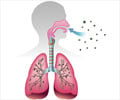Paratracheal abscess by plant fungus Chondrostereum purpureum- first case report of human infection.
- Climate change and urbanization are contributing to the emergence of fungal illnesses in humans
- Fungal pathogens infect over 150 million people each year and cause approximately 1.7 million fatalities
- A plant fungus, Chondrostereum purpureum, causes tracheal abscesses in the first reported human infection
Paratracheal abscess by plant fungus Chondrostereum purpureum- first case report of human infection
Go to source).
World's First Human to be Diagnosed With a Rare Plant Fungal Disease
The patient, who was 61 at the time of the diagnosis, recovered completely and has had no recurrence of the infection after two years of monitoring. Yet, this "first of its type" case study demonstrates the risks that fungal pathogens represent for humans, particularly since climate change and other human activities, such as rampant urbanization, have opened a "Pandora's Box for emerging fungal illnesses," according to the report.Fungal pathogens are having a moment in pop culture since they are the basis of a fictional disease represented in the post-apocalyptic video game The Last of Us, which was recently converted into the critically acclaimed HBO series of the same name. Yet, these microorganisms constitute a real-life scourge, infecting over 150 million people each year and causing approximately 1.7 million fatalities.
Although there are millions of fungal species, only a small percentage of them may infect animals, including humans, because our bodies present obstacles to these invaders, such as high temperatures and complex immune systems.
With their unusual report of a C. purpureum infection, Soma Dutta and Ujjwayini Ray of Apollo Multispecialty Hospitals in Kolkata, India, have added one more fungus to that limited list of human invaders. The patient, a plant mycologist, had been suffering from cough, exhaustion, anorexia, and a throat abscess for months before his hospital visit and was most likely exposed to the fungus as a result of his job.
How did they find the Culprit of this Fungal disease?
When conventional methods failed to identify the pathogen, it was moved to a World Health Organization facility in India, where it was finally identified via DNA sequencing. The case "highlights the potential of environmental plant fungi to cause disease in humans and stresses the importance of molecular techniques to identify the causative fungal species," according to their recent study in the journal Medical Mycology Case Reports."This is the first case of its kind wherein this plant fungus caused disease in a human," Dutta and Ray said in the study. "This case report demonstrates the crossover of plant pathogens into humans when working in close contact with plant fungi. The cross-kingdom pathogenicity demands much work be done in order to explore insights into the mechanisms involved, thus leading to possible recommendations to control and contain these infections."
Silver Leaf Disease of Plants
Purpureum can cause silver leaf disease in a range of plants. The disease is named after the color that the pathogen causes on the leaves of the hosts. It is the most recent in a long line of fungal infections that have infected humans, aided in part by human activities such as urbanization, travel, and commerce.Probable Cause of Transmission of Plant Fungus in Humans
In the aftermath of catastrophic weather events, human-caused climate change is also hastening the spread of infectious diseases, especially fungal pathogens, by allowing bacteria to adapt to higher temperatures (like those found in mammalian bodies), increase their range, and interact with new hosts. Therefore, while fungal illnesses have a lesser epidemiological profile than other pathogens, they may be more harmful."While viral and bacterial diseases receive the most attention as the potential causes of plagues and pandemics, fungi can arguably pose equal or even greater threats,"
According to a 2021 study in PLoS Pathogens. "There are no vaccines available yet for fungal pathogens, the arsenal of antifungal agents is extremely limited, and fungi can live saprotrophically, producing large quantities of infectious spores, and do not require host-to-host contact to establish infection. Indeed, fungi seem to be uniquely capable of causing complete host extinction."
In addition to preventing the introduction of new fungal illnesses that can directly infect humans, researchers highlight the harm these diseases can cause to crops and ecosystems on which people rely. As a result, Dutta and Ray advocate for deeper research into the biology of these illnesses and measures to combat their spread.
Plant Fungus: Destruction of Crops; Impacts Humanity
"Cross-kingdom human pathogens and their potential plant reservoirs have important implications for the emergence of infectious diseases," Dutta and Ray said. "Fungi are also responsible for various infections in plants that cause the destruction of millions of plants and crops and produce toxins that contaminate food and cause acute toxicity.""Over the past several decades, multiple new pathogenic fungi have emerged," they concluded. "A notable emergence of the multidrug-resistant fungus Candida auris has spread all over the world and has become a significant threat. The worsening of global warming and other civilizational activities opens Pandora's Box for newer fungal diseases."
Reference:
- Paratracheal abscess by plant fungus Chondrostereum purpureum- first case report of human infection - (https://www.sciencedirect.com/science/article/pii/S2211753923000106)
Source-Medindia














